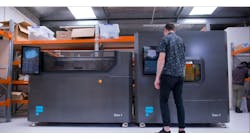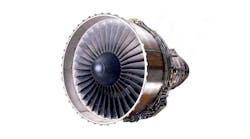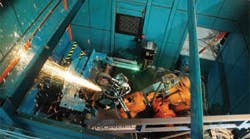Vulcan Engineering’s 3D line-scanning makes robotic grinding of large castings efficient and repeatable.
More than ever before, business leaders seek to maximize the value of their capital investments. Today’s industrial robots, as well as the complementary technologies, offer features and capabilities that represent a historically unmatched “best buy,” and an extraordinary new opportunity for metalcasters.
The early development of robotics was driven primarily by the automotive industry. Their capabilities, and ease of use, were essentially limited by the state of computing and electronics. Developing alongside those dynamic technologies though, robots have enjoyed equally impressive growth in capability and cost ratio. But, in the modern world we understand too well the struggle to keep pace with technology.
In consumer goods, we witness the daily tug-of-war between cost and the “state of the art” every day, and our efforts to stay at the technological forefront often seem futile. However, considering an industrial robot (a depreciable capital asset), investing in current technology is essential to achieving the maximum benefit of flexible automation.
Since industrial robots’ debut in automotive diecasting in the early 1960s, their core characteristics — accuracy and precision, reach and payload capacity, speed, and power — have continuously improved. But, recent improvements in ruggedness and overall reliability make today’s robots especially attractive to metalcasters. Moreover, integrated technologies for robot guidance, sensory feedback and user/programmer interface make the current robot offerings more versatile and more “intelligent” than ever. So effective are these technologies that in recent years there have been a number of partnerships established between robot manufacturers and sensor manufacturers in particular.
Robot guidance is not new, but machine vision manufacturers have advanced the quality, speed, resolution, durability, form factor and user-friendliness of their wares to such an extent that they have opened many new areas to robotic automation. Whether they use 2D, 3D, or 3D line-scan methodology, these products function as the robot’s “eyes,” caliper, and micrometer. They help to reduce or eliminate fixturing and hard-tooling, allowing greater flexibility (and perhaps the elusive single-piece flow.) Now, they can also act as real-time, 100% dimensional inspectors or map the surface of a casting to sense exactly where material should be removed in a finishing operation, helping to compensate for part variation. Vulcan has used 3D line-scan technology for efficient and repeatable robotic grinding of large steel components where dimensions routinely vary more than 15 mm.
Integrated force sensing is perhaps the most compelling recent advance in sensory feedback for robots. Systems currently available allow robots to sense force and torque in all directions, for delicate tasks like component assembly, and for highly efficient material removal processes. They are particularly impressive at the pressure-critical task of grinding, and the latest force-control capabilities make it possible for the robot to maintain optimal normal force and feed force, and to react intelligently to the forces encountered.
For instance, the robot can adjust its speed, alter its path or even change its sequence of operation altogether, based on the conditions it senses. This capability is very beneficial in applications such as the FOXALL Automated Casting Finishing System. In the FOXALL, Vulcan takes advantage of ABB’s “Force Control for Machining” system to reduce grinding cycle time by as much as 20%, while simultaneously enhancing grinding wheel life and adding a layer of protection to the machine components. In addition to enhancing the process, the Force Control system provides an innovative way to program the robot. The programmer can drag the end of the robot arm (which is sensing the applied forces) through the desired path around the workpiece to teach the necessary points. The robot then optimizes the path autonomously by maintaining a constant force against the workpiece and teaching itself new points as required.
Robot integrators and solution developers bridge the gap between robot manufacturers and end users, driving much of the innovation and application diversity in the industry. Leveraging the technologies available from the world’s leading robot manufacturers with the latest in peripheral equipment, such solution providers offer metalcasters unprecedented opportunities for process improvement, capability/capacity enhancement and cost reduction.
Michael Aughtman is a sales engineer with Vulcan Engineering Co. For information, visit www.vulcangroup.com, or in Europe, or www.vulcaneurope.com









